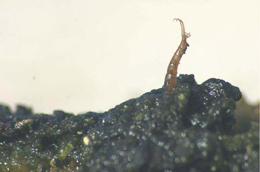Published online 15 May 2011 | Nature | doi:10.1038/news.2011.290
News
Bacteria helped early animals to breathe
Microbial mats might have functioned as oxygen oases for primitive multicellular life.
 Animals can use the pockets of oxygen trapped in mats of photosynthetic bacteria to survive in anoxic environments.
Animals can use the pockets of oxygen trapped in mats of photosynthetic bacteria to survive in anoxic environments.Mats of plant-like bacteria dramatically increase local oxygen levels in the lakes where they are found, as a result of photosynthesis. That might have given early multicellular animals the boost they needed to evolve in an ancient world where oxygen was scarce.
A study exploring this idea, published today in Nature Geoscience1, analyses bacterial colonies called microbial mats in the Los Roques lagoons of Venezuela.
Like most modern microbial mats, those in Los Roques have a surface layer of blue-green algae, or cyanobacteria, which collect the bulk of their energy from the Sun, and a lower layer of sulphide-oxidizing bacteria. However, unlike most mats today, those in Los Roques are found in highly saline waters that are inhospitable to most of the plant-eating animals that would normally graze on them. The mats can therefore completely cover lagoon floors and behave very much as such mats would have done in the Ediacaran Period, 542 million years ago, when multicellular animals were only just starting to evolve.
Murray Gingras, a palaeontologist at the University of Alberta in Edmonton, Canada, examined the chemistry of the water above and inside the living mats. He and his colleagues found that although oxygen levels in the surface waters of the lagoon were very low, often reaching 0.10 units of atmospheric pressure (atm), daytime levels in deeper waters near the mat rose to between 0.25 and 0.45 atm as the bacteria produced energy from sunlight and released oxygen as a waste product.
In the top millimetre layer of the mat itself, the team discovered an environment of nearly pure oxygen, with daytime measurements of up to 1.05 atm.
Modern atmospheric oxygen levels average around 0.21 atm, but when multicellular life was evolving, levels of around 0.10 atm would have been the norm — too low for most multicellular organisms. "Daily fluctuations in oxygen would have made it very difficult for animals other than simple creatures like sponges to exist," explains Jim Gehling, a palaeontologist at the South Australian Museum in Adelaide.
Gingras and his colleagues propose that the mats had a key role in helping early animals to get the oxygen they needed. "We think that animals used the small but highly oxygenated zones as oases," says Murray.
Oxygen tanks
Palaeontologists have long theorized that early animals fed on microbial mats, because fossils of animals and mats are often found together. But this is the first time that researchers have shown how mats can function as important oxygen resources for fauna.
"The idea that microbial or even algal colonies could have provided oxygenic havens for early life is an intriguing one," says Martin Brasier, a palaeobiologist at the University of Oxford, UK.
Gehling agrees that it is a "neat idea", but there are some glitches.
Because the rich oxygen supply is created by photosynthesis, it would only have been available when the sun was shining. At night, the environment around the mats would have become oxygen-deficient, as Murray and his colleagues saw in the Venezuelan lagoons.
Insect larvae that live inside the modern lagoon mats go into a state of hibernation after nightfall to cope with the sudden loss of oxygen, but it is not known whether early animals could do the same.
Gehling also points out that early animals that might have used the microbial mats' oxygen were much larger than the insect larvae that live inside modern mats, and would have had difficulty benefiting from the high-oxygen environment in the mats' narrow top layer.
Gingras counters that not all Ediacaran animals were large, pointing to trace-fossil evidence that include the burrows of millimetre-scale worm-like animals. In addition, the oases provide oxygen not only to the immediate mat area, but also to the water above the mat.
"Larger animals may have used mat-hugging behaviours from above to benefit from the high oxygen gradient near the mat," he says.
Perhaps the most important matter that demands further attention is whether the mats of the past really behaved like the mats of the present. "What we now need is good evidence that the Ediacaran mats were photosynthetic," says Brasier.